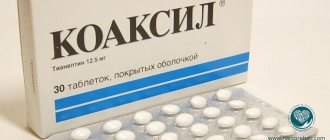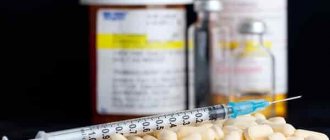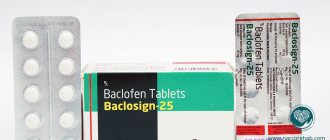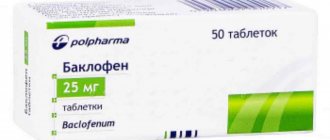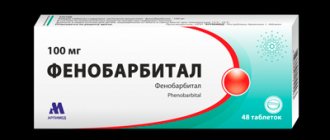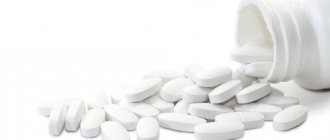Domestic tranquilizer. One of the most powerful tranquilizers. Combines sedative, hypnotic and anti-anxiety properties. It is widely used to treat mental disorders, alcohol and drug addiction, seizures and other neurological diseases.
The active substance is bromodihydrochlorophenylbenzodiazepine. Available in the form of tablets of 0.5; 1 and 2.5 milligrams and in the form of a 0.1% solution for intramuscular and intravenous administration in 1 milliliter ampoules.
The effect of the drug is achieved by enhancing the inhibitory effect of gamma-aminobutyric acid on the subcortical structures of the brain. It affects benzodiazepine receptors of neurons, triggering inhibition processes.
Content
- special instructions
- Directions for use and doses
- Interaction with other drugs
- Contraindications for phenazepam
- With caution (precautionary measures)
- Composition of phenazepam
- Expiration date from date of manufacture
- Storage conditions for phenazepam
- Side effect
- Product description
- Release form phenazepam
- Overdose of phenazepam
- Indications for use of phenazepam
- Use during pregnancy and lactation
- Pharmacokinetics
- pharmachologic effect
Compound
| Solution for intravenous and intramuscular administration | 1 ml |
| active substance: | |
| bromodihydrochlorophenylbenzodiazepine (phenazepam) | 1 mg |
| excipients: povidone (low molecular weight medical polyvinylpyrrolidone) - 9 mg; glycerol (glycerin) - 100 mg; sodium disulfite (sodium pyrosulfite) - 2 mg; polysorbate 80 (Tween 80) - 50 mg; sodium hydroxide solution (caustic soda) 1 M - to pH 6–7.5; water for injection - up to 1 ml |
special instructions
Use with caution in case of liver and/or renal failure, cerebral and spinal ataxia, history of drug dependence, tendency to abuse psychoactive drugs, hyperkinesis, organic brain diseases, psychosis (paradoxical reactions are possible), hypoproteinemia, sleep apnea (established or suspected ), in elderly patients. In case of renal and/or liver failure and long-term treatment, it is necessary to monitor the peripheral blood picture and the activity of liver enzymes. Patients who have not previously taken psychoactive drugs exhibit a therapeutic response to the use of phenazepam in lower doses compared to patients taking antidepressants, anxiolytics, or alcoholism. Like other benzodiazepines, it has the ability to cause drug dependence when taken long-term in large doses (more than 4 mg/day). If you suddenly stop taking it, withdrawal symptoms may occur (including depression, irritability, insomnia, increased sweating), especially with long-term use (more than 8-12 weeks). If patients experience unusual reactions such as increased aggressiveness, acute states of agitation, feelings of fear, thoughts of suicide, hallucinations, increased muscle cramps, difficulty falling asleep, shallow sleep, treatment should be discontinued. During treatment, patients are strictly prohibited from consuming ethanol. The effectiveness and safety of the drug in patients under 18 years of age have not been established. In case of overdose, severe drowsiness, prolonged confusion, decreased reflexes, prolonged dysarthria, nystagmus, tremor, bradycardia, shortness of breath or difficulty breathing, decreased blood pressure, and coma are possible. Gastric lavage and activated charcoal are recommended; symptomatic therapy (maintaining breathing and blood pressure), administration of flumazenil (in a hospital setting); hemodialysis is ineffective. Effect on the ability to drive vehicles and operate machinery During the treatment period, care must be taken when driving vehicles and engaging in other potentially hazardous activities that require increased concentration and speed of psychomotor reactions.
Directions for use and doses
Orally: for sleep disorders - 250-500 mcg 20-30 minutes before bedtime. For the treatment of neurotic, psychopathic, neurosis-like and psychopath-like conditions, the initial dose is 0.5-1 mg 2-3 times a day. After 2-4 days, taking into account effectiveness and tolerability, the dose can be increased to 4-6 mg/day. In cases of severe agitation, fear, and anxiety, treatment begins with a dose of 3 mg/day, quickly increasing the dose until a therapeutic effect is obtained. For the treatment of epilepsy - 2-10 mg/day. For the treatment of alcohol withdrawal - orally, 2-5 mg / day or intramuscularly, 500 mcg 1-2 times / day, for vegetative paroxysms - intramuscularly, 0.5-1 mg. The average daily dose is 1.5-5 mg, divided into 2-3 doses, usually 0.5-1 mg in the morning and afternoon and up to 2.5 mg at night. In neurological practice, for diseases with muscle hypertonicity, 2-3 mg is prescribed 1-2 times a day. The maximum daily dose is 10 mg. To avoid the development of drug dependence during a course of treatment, the duration of use of phenazepam is 2 weeks (in some cases, the duration of treatment can be increased to 2 months). When discontinuing phenazepam, the dose is reduced gradually.
Addiction treatment
Treatment for benzodiazepine addiction follows standard regimens. However, the approach to patients is always individual - each clinical case has its own characteristics. Treatment begins with the safe removal of all psychotropic substances, supporting the person until complete resocialization.
Detoxification
The largest number of hospitalizations occur in cases of phenazepam poisoning. Addicts also seek help during withdrawal periods. Detoxification is carried out using the following methods:
- Gastric and intestinal lavage followed by administration of sorbents.
- Controlled administration of a benzodiazepine receptor antagonist, Flumazenil.
- Droppers with antitoxic solutions, glucose, electrolytes.
- Cardiotonic drugs to support cardiac activity.
- Oxygen therapy.
- Symptomatic treatment.
The effectiveness of extracorporeal blood purification (hemodialysis) has not yet been proven. In the hospital, all manifestations of “withdrawal” are painlessly relieved.
Patients with mild illness can receive care at home (anonymously), but further treatment is still required.
Rehabilitation and resocialization
After restoration of the impaired functions of internal organs, treatment is started aimed at preventing relapses. It includes individually selected psychotherapeutic techniques. With the help of a doctor, a person finds the origins of his addiction, normalizes his emotional background, and learns to deal with life’s failures.
An important part of rehabilitation is helping codependent family members. Often relatives suffer no less than the patient, which negatively affects their health. The psychotherapist helps restore normal relationships between loved ones, which increases the patient’s chances of a successful outcome.
After treatment, it is difficult for patients to return back to a society that rejects drug addicts in every possible way. Regular consultations with a doctor help solve current problems without causing a breakdown. If necessary, social services help with studying or getting a job.
Interaction with other drugs
When used simultaneously, phenazepam reduces the effectiveness of levodopa in patients with parkinsonism. Phenazepam may increase the toxicity of zidovudine. There is a mutual enhancement of the effect with the simultaneous use of antipsychotic, antiepileptic or hypnotics, as well as central muscle relaxants, narcotic analgesics, ethanol. Microsomal oxidation inhibitors increase the risk of toxic effects. Inducers of microsomal liver enzymes reduce effectiveness. Increases the concentration of imipramine in the blood serum. When used simultaneously with antihypertensive drugs, the antihypertensive effect may be enhanced. Increased respiratory depression may occur during concomitant administration of clozapine.
Safety of Phenazepam
Phenazepam is a relatively safe drug. But this statement is only true if the patient takes it in accordance with the dosage and in cases prescribed by the doctor. Some drug addicts use the medicine together with the drug to enhance the effect. This is a very dangerous combination that can lead to death. There are also known fatal cases after using Phenazepam and other psychostimulants.
The half-life of Phenazepam from the body does not exceed 10 hours. However, in some patients, especially those with liver disease, this time almost doubles. To safely take Phenazepam, you should wait 2 to 3 days after your last drink.
Alcohol dependence increases the risk of developing dependence on this tranquilizer. Therefore, in case of alcoholism, the drug is prescribed with great caution and for a short time. It is ideal if the patient takes Phenazepam to relieve withdrawal symptoms. Subsequently, the patient is prescribed sedatives that have a milder effect.
Alcoholic drinks are strictly prohibited during treatment with Phenazepam. Only a doctor can tell you when you can drink alcohol after undergoing treatment.
Contraindications for Phenazepam
Coma, shock, myasthenia gravis, angle-closure glaucoma (acute attack or predisposition), acute poisoning with alcohol (with weakening of vital functions), narcotic analgesics and hypnotics, severe COPD (possible increased respiratory failure), acute respiratory failure, severe depression (may occur suicidal tendencies); I trimester of pregnancy, lactation period, childhood and adolescence up to 18 years (safety and effectiveness have not been determined), hypersensitivity (including to other benzodiazepines).
Indications and contraindications for treatment with Phenazepam
Instructions for use indicate various pathological conditions for which the drug is effective:
- for neuroses, psychopathy, accompanied by sudden changes in mood, anxiety, irritation, fear, tension;
- reactive psychoses, sleep disorders;
- hypochondria, autonomic dysfunction syndrome;
- epilepsy, panic attacks, dyskinesias, nervous tics;
- to prevent phobias and similar conditions;
- with increased muscle tone and rigidity;
- lability of the autonomic nervous system;
- alcohol withdrawal.
The drug is used in preliminary preparation before surgery and general anesthesia.
Phenazepam is included in the list of potent medications, has many contraindications for use and is changed for certain categories of patients. The drug is not prescribed to patients:
- in coma or shock;
- with myasthenia gravis, angle-closure glaucoma - in case of an acute attack or hereditary predisposition;
- with COPD, acute respiratory failure;
- minors, pregnant and lactating women;
- with individual intolerance to the component composition.
Supervision by a specialist during therapy is necessary for patients with renal or hepatic dysfunction. Increased caution is required when treating people with drug addiction syndrome, psychological dependence on medications, and in old age.
Side effect
From the side of the central nervous system and peripheral nervous system: at the beginning of treatment (especially in elderly patients) - drowsiness, feeling of fatigue, dizziness, decreased ability to concentrate, ataxia, disorientation, unsteady gait, slowed mental and motor reactions, confusion; rarely - headache, euphoria, depression, tremor, memory loss, impaired coordination of movements (especially at high doses), depressed mood, dystonic extrapyramidal reactions (uncontrolled movements, including the eye), asthenia, myasthenia gravis, dysarthria, epileptic seizures (in patients with epilepsy); extremely rarely - paradoxical reactions (aggressive outbursts, psychomotor agitation, fear, suicidal tendencies, muscle spasms, hallucinations, agitation, irritability, anxiety, insomnia). From the hematopoietic organs: leukopenia, neutropenia, agranulocytosis (chills, hyperthermia, sore throat, excessive fatigue or weakness), anemia, thrombocytopenia. From the digestive system: dry mouth or drooling, heartburn, nausea, vomiting, loss of appetite, constipation or diarrhea; liver dysfunction, increased activity of liver transaminases and alkaline phosphatase, jaundice. From the genitourinary system: urinary incontinence, urinary retention, renal dysfunction, decreased or increased libido, dysmenorrhea. Allergic reactions: skin rash, itching. Local reactions: phlebitis or venous thrombosis (redness, swelling or pain at the injection site). Other: addiction, drug dependence; decrease in blood pressure; rarely - visual impairment (diplopia), weight loss, tachycardia. If the dose is sharply reduced or taken is stopped, withdrawal syndrome occurs (irritability, nervousness, sleep disturbances, dysphoria, spasm of smooth muscles of internal organs and skeletal muscles, depersonalization, increased sweating, depression, nausea, vomiting, tremor, perception disorders, incl. hyperacusis, paresthesia, photophobia; tachycardia, convulsions, rarely - acute psychosis).
Adverse reactions during therapy with Phenazepam
Non-standard reactions of the body arise against the background of the above contraindications or as an individual reaction of the body. The problem is related to the influence of the components on the functionality of the nervous system.
The majority of those undergoing the procedure experience increased drowsiness, chronic fatigue, lethargy, and attacks of dizziness. Patients complain of impaired concentration, problems with orientation in space, symptoms of ataxia, confusion, and slow psychomotor reactions.
A list of rarer side effects from Phenazepam is presented:
- cephalgia, euphoria;
- depression, tremor;
- problems with memory, coordination of movements;
- asthenia, myasthenia, dysarthria.
Occasionally, therapeutic manipulations provoke attacks of aggression, phobias, and hallucinations. Patients develop suicidal tendencies, insomnia, and muscle spasticity.
When the digestive tract is damaged, the following occurs:
- dryness of the oral mucosa;
- involuntary secretion of saliva;
- refusal to eat, constipation with diarrhea;
- heartburn, nausea, yellowing of the skin;
- increased activity of liver enzymes.
Therapy with Phenazepam can cause increased or decreased sexual desire and symptoms of dysmenorrhea. Some patients experience allergies with skin rashes and obsessive itching. A list of other adverse reactions is presented:
- addiction and development of drug dependence;
- drop in blood pressure level;
- impaired vision clarity with doubling of objects;
- weight loss, heart rhythm disturbances.
With a sharp reduction in dosage or stopping treatment, withdrawal syndrome occurs. Clinical signs of the pathology resemble the symptoms that led to the need for Phenazepam procedures.
Indications for use Phenazepam
Neurotic, neurosis-like, psychopathic and psychopath-like and other conditions (irritability, anxiety, nervous tension, emotional lability), reactive psychoses and senesto-hypochondriacal disorders (including those resistant to the action of other anxiolytic drugs (tranquilizers), obsession, insomnia, withdrawal syndrome (alcoholism, substance abuse), status epilepticus, epileptic seizures (of various etiologies), temporal lobe and myoclonic epilepsy. In extreme conditions - as a means of facilitating overcoming feelings of fear and emotional stress. As an antipsychotic - schizophrenia with increased sensitivity to antipsychotic drugs (including febrile form).In neurological practice - muscle rigidity, athetosis, hyperkinesis, tic, autonomic lability (paroxysms of sympathoadrenal and mixed nature).In anesthesiology - premedication (as a component of induction of anesthesia).
Nosological classification (ICD-10)
- F06.6 Organic emotionally labile [asthenic] disorder
- F29 Non-organic psychosis, unspecified
- F40 Phobic anxiety disorders
- F40.9 Phobic anxiety disorder, unspecified
- F41 Other anxiety disorders
- F45 Somatoform disorders
- F45.2 Hypochondriacal disorder
- F48 Other neurotic disorders
- F48.0 Neurasthenia
- F51.0 Insomnia of non-organic etiology
- F60.2 Dissocial personality disorder
- F60.3 Emotionally unstable personality disorder
- F95 Tiki
- G25.9 Extrapyramidal and movement disorder, unspecified
- G40 Epilepsy
- G47.0 Disturbances in falling asleep and maintaining sleep [insomnia]
- R25.8.0* Hyperkinesis
- R45.0 Nervousness
- R45.4 Irritability and anger
Use during pregnancy and lactation
During pregnancy, use is possible only for health reasons. It has a toxic effect on the fetus and increases the development of birth defects when used in the first trimester of pregnancy. When taken in therapeutic doses later in pregnancy, it may cause CNS depression in the newborn. Chronic use during pregnancy can lead to physical dependence with the development of withdrawal syndrome in the newborn. Children, especially young children, are very sensitive to the CNS depressant effects of benzodiazepines. Use immediately before or during childbirth may cause respiratory depression in the newborn, decreased muscle tone, hypotension, hypothermia and weak sucking ("floppy baby" syndrome).
pharmachologic effect
Anxiolytic drug (tranquilizer) of the benzodiazepine series. It has anxiolytic, sedative-hypnotic, anticonvulsant and central muscle relaxant effects. Strengthens the inhibitory effect of GABA on the transmission of nerve impulses. Stimulates benzodiazepine receptors located in the allosteric center of postsynaptic GABA receptors of the ascending activating reticular formation of the brain stem and interneurons of the lateral horns of the spinal cord; reduces the excitability of subcortical structures of the brain (limbic system, thalamus, hypothalamus), inhibits polysynaptic spinal reflexes. The anxiolytic effect is due to the influence on the amygdala complex of the limbic system and manifests itself in a decrease in emotional stress, easing anxiety, fear, and restlessness. The sedative effect is due to the influence on the reticular formation of the brain stem and nonspecific nuclei of the thalamus and is manifested by a decrease in symptoms of neurotic origin (anxiety, fear). The productive symptoms of psychotic origin (acute delusional, hallucinatory, affective disorders) are practically not affected; a decrease in affective tension and delusional disorders is rarely observed. The hypnotic effect is associated with inhibition of the cells of the reticular formation of the brain stem. Reduces the impact of emotional, vegetative and motor stimuli that disrupt the mechanism of falling asleep. The anticonvulsant effect is realized by enhancing presynaptic inhibition, suppresses the propagation of the convulsive impulse, but does not relieve the excited state of the focus. The central muscle relaxant effect is due to inhibition of polysynaptic spinal afferent inhibitory pathways (to a lesser extent, monosynaptic ones). Direct inhibition of motor nerves and muscle function is also possible.
